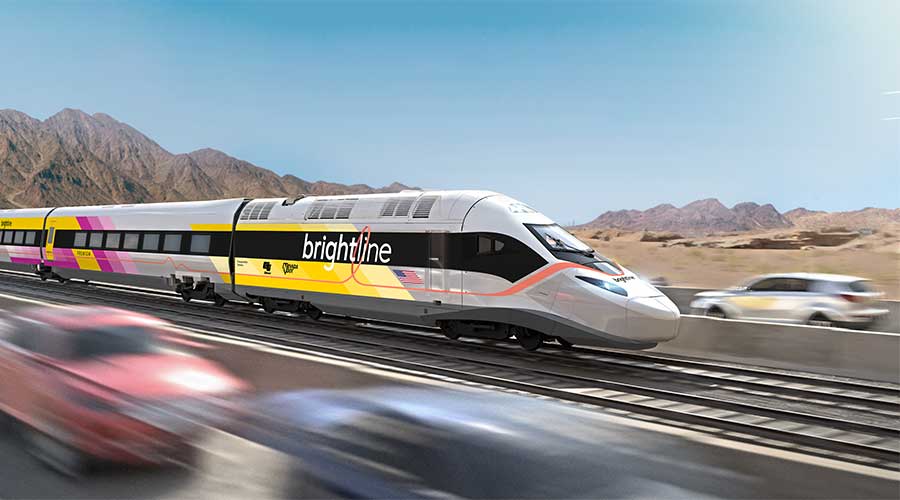Stay updated on news, articles and information for the rail industry
December 2010
Part 1 : Rail Outlook: 2011
Class I Outlook: 'Year of Opportunity'
Part 4 : 'Certainty is what drives investment' — AAR's Ed Hamberger
Part 5 : Short-Line Outlook 2011
Part 6 :
Passenger Rail Outlook 2011 - 'Still a Little Tenuous'
High-Speed Rail: In flux in 2011
Part 8 : Rail-Car Deliveries in 2011
Rail News: Passenger RailPassenger Rail Outlook 2011 - 'Still a Little Tenuous'
— by Angela Cotey, Associate Editor
Most U.S. transit agencies are emerging from the worst economic crisis since the Great Depression the same way many U.S. citizens are — with fewer dollars in their pocketbooks, pared-back spending habits and a hesitancy to forecast the future.
Examples of the recession's impact on transit agencies was apparent throughout 2010. The Regional Transportation District of Denver (RTD) has been examining ways to carry out its FasTracks expansion program despite plummeting sales tax revenue and skyrocketing construction costs. The Chicago Transit Authority (CTA), among many other agencies, trimmed service in an effort to cut costs while minimizing rider impact. The Northstar Corridor Development Authority put expansion plans for its commuter-rail line on hold. And New Jersey Gov. Chris Christie terminated New Jersey Transit's Access to the Region's Core project after discovering the project could run as much as $5 billion over budget.
Of course, budget woes are par for the transit-agency course. Doomsday-type scenarios aren't unusual for publicly funded entities, nor are threats of severe cost-cutting measures. But the past two years have given new meaning to the term "budget crisis." Instead of eliminating positions through attrition, agencies cut hundreds of workers. Instead of implementing a minimal fare increase, they've instituted price hikes reaching 7 percent or higher. Instead of tinkering with increased headways or cut-backs on weekend trains, agencies have slashed service, some by as much as 20 percent. As the economic outlook improves, the tough decisions that transit officials have had to make in recent years — and the way those decisions have shaped their respective agencies — have left a lasting impact.
"We're a whole new organization. We've had to learn to be much more efficient and aggressive," says CTA President Richard Rodriguez. "That's [CTA's] mentality now — hyper-analyzing everything when we spend an additional dollar."
Not that it's a bad thing. The lessons agency officials have learned during the economic crisis will help them in 2011 and beyond. It'll take some time to regain the service and ridership levels — not to mention confidence — the transit industry was boasting a few years back. But as long as the coming year isn't as bad as the past two — and the transit execs Progressive Railroading interviewed for its "2011 Outlook" cover story don't believe it will be — agency managers can begin taking small steps down the road to recovery while continuing to focus on bigger-picture expansion programs and federal funding issues.
"Things are starting to look better, though everything's still a little tenuous," says Dallas Area Rapid Transit (DART) President and Executive Director Gary Thomas. "People are thinking, 'Is the ice thick enough to walk on yet?'"
More Solid Ground
For DART, there are some signs it might be solidifying. In mid-November, the agency received September sales tax figures that showed a 5 percent increase year over year.
"Normally, I'd be the first to say that one month doesn't constitute a trend, but I sure liked September and I'll be rooting for October," he says.
The agency needs those figures to continue climbing upward in order for DART to meet its 2011 budget and reinstate some service.
"We were cutting service at the same time ridership was starting to decline, so we were able to minimize the impact on customers," says Thomas. "But as the economy starts to come back, we have to be in a position to restore some of that service."
And they need to be able to do it at a price riders can afford. Denver RTD General Manager Phillip Washington says his agency will raise fares in January, but doesn't plan to issue any additional ticket price hikes for at least 12 to 18 months.
"At some point, you raise fares to a degree where people find it cheaper to drive their cars," he says. "You can kind of price yourself out of the market."
The good news: Sales tax revenue in the Denver area has risen slightly during the past six to eight months, a sign that "maybe the economy is coming back," says Washington.
Other transit execs were equally hesitant to predict a significant economic comeback in 2011.
"We see signs of a recovery, little as it may be," says CTA's Rodriguez. "But I don't know that we'll ever see things the way they were a few years back before everything crashed."
Making Ends Meet
In November, CTA's board approved a $1.3 billion 2011 budget that maintains fares and service levels. However, the agency transferred $113 million in capital funds to the operating budget in order to balance the spending plan.
But that's nothing compared with 2010, when CTA slashed rail and bus service by a total of 20 percent and laid off 1,000 workers. In recent months, CTA has called back about 50 percent of the employees as others have left the agency or retired. If CTA can re-hire the remainder of those workers in 2011, so much the better, Rodriguez says.
"Will 2011 will meet everyone's expectations? I don't think so," he says. "But for now, if we can maintain service and bounce back through just attrition alone, I'm optimistic."
Los Angeles County Transportation Authority (LACMTA) Chief Executive Officer Art Leahy will be satisfied if economic indicators hold steady in 2011, too. In the Los Angeles area, retail sales have leveled off, although they're still down about 20 percent from a couple of years ago, and real estate prices have improved a tad.
But there's no guarantee things will stay that way. The state is dealing with a massive budget deficit that could affect transit agencies.
"We receive a fair amount of money from the state and if that revenue stream falls off, we'd have a big problem," says Leahy. "And, we have a new governor who's a fiscal conservative."
As a result, LACMTA's outlook is "tenuous," says Leahy.
"I don't think anyone here is screaming optimism," he says. "We've had a malaise the likes of which nobody has ever seen before."
Like most other transit agencies, the South Florida Regional Transportation Authority (SFRTA) — which operates Tri-Rail commuter-rail service — faced that malaise first-hand. After learning the three counties that fund SFRTA were cutting their 2009 contribution due to local budget crises, the agency was faced with eliminating weekend service and slashing its 50-train weekday service by 20 trains.
During a December 2009 special session, the Florida legislature approved a $13.5 million annual contribution to the agency. The additional funds enabled the agency to maintain its 50-train operation in 2010.
In comparison with last year's service scare, 2011 doesn't look too shabby, says Executive Director Joseph Giulietti.
"Are things different from a year ago when I didn't know if I could keep my 50 trains going? Yeah," he says. "We're not there yet, but we are OK."
But during tough economic times, "OK" isn't a bad position to be in. And it's not stopping many transit agencies from working to improve or expand service. They're also determining different ways to generate revenue and complete projects.
"We need to think about how we can keep our riders and attract new ones," says CTA's Rodriguez. "And on the funding side, what can we do to obtain more funds and not be as dependent on public dollars?"
To improve service, CTA plans to implement a train-tracking system so passengers know when the next train is coming, replace about one-third of its rail-car fleet, and reconstruct and build stations.
To generate revenue, CTA plans to launch a corporate sponsorship program to analyze branding opportunities for rail stations, rail lines and bus routes, says Rodriguez.
At SFRTA, agency officials have exercised an option to purchase 10 additional rail cars from Hyundai Rotem. The agency also plans to purchase at least 10 locomotives during the next two years.
The additional rolling stock will provide SFRTA with a fleet that's easier and less costly to maintain, as well as more back-up equipment. But if SFRTA wants to expand service, it'll need a dedicated funding source from the state, says Giulietti, adding that, with a new governor set to take office in January, there's no telling if legislators will approve such funding.
In the meantime, agency officials will examine their service-expansion options on a Florida East Coast Railway corridor between Jupiter and downtown Miami. They'll also explore options to implement light-rail service on east-west corridors that could connect to the commuter-rail system and partner with other Florida agencies that seek to build commuter-rail systems, says Giulietti.
Thinking Outside the Box
Meanwhile, other agencies are in the throes of expansion plans that were approved in better economic times, and are using the difficult financial environment as an opportunity to develop new financing strategies.
In June, Denver RTD awarded a contract to Denver Transit Partners — a consortium comprising Ames Construction, Balfour Beatty Rail Inc., Alternate Concepts Inc. and HDR, as well as sponsors Flour Enterprises Inc. and Macquarie Capital Group Ltd. — to design, build, finance, operate and maintain three FasTracks corridors. The pact reduces the amount of cash RTD needs to front for the project. The public-private partnership has provided some much-needed relief to RTD's FasTracks program, which is facing a multi-billion-dollar budget gap.
Now, the agency is reviewing options to advance the program — which calls for building six new rail corridors and extending three existing ones, as well as redeveloping Denver Union Station — with the $305 million remaining in the FasTracks pot. RTD also plans to pursue additional funding to complete the entire program, albeit later than the original 2017 target. Early next year, RTD officials hope to determine whether to ask voters for an additional sales tax increase, and the size of that increase.
Although completing a large-scale expansion program on time and on budget is no easy task, LACMTA officials are trying to do both.
In 2008, Los Angeles County voters approved Measure R, a half-cent sales tax measure expected to generate about $40 billion during the next 30 years for transit and highway projects.
To stay within budget, agency officials are "devoting intense levels of attention to project management," says LACMTA's Leahy. This month, the agency expects to issue a report to the board recommending the creation of "self-disciplined" milestones for each project that would enable project managers to check design assumptions and cost projections each step of the way, he says. That way, if a problem arises, officials can address it immediately.
"We must be more diligent about that to ensure cost control," says Leahy.
LACMTA officials also are hoping to accelerate the capital program. In April, the agency's board approved a 30/10 initiative that calls for completing the Measure R subway and light-rail projects in 10 years instead of 30 by coupling Measure R dollars with long-term bonds and federal loans.
On the Fast Track
DART officials are examining ways to accelerate their expansion program, as well. The agency is in the midst of a plan to double its light-rail system by 2014. With construction on most segments complete or under way, DART is considering future expansion plans, such as a Blue Line extension to South Dallas. The line isn't expected to be complete until 2019, but the agency could enter into a partnership with a contractor to move up the start date.
"A lot of construction contractors don't have a lot of backlog because of the economy," says DART's Thomas. "If a contractor was willing to give us some short-term money on that kind of project, then we could start construction sooner, they could keep their crews busy and employed, and we could pay them back later."
A new surface transportation authorization bill would help advance transit projects, as well. The current bill — The Safe, Accountable, Flexible and Efficient Transportation Equity Act: A Legacy for Users — expired in December 2009 and has since been extended several times. The most recent extension expires at year's end.
The American Public Transportation Association (APTA) is lobbying for a bill that provides $123 billion for public transportation over a six-year period, says Caltrain Executive Director and APTA Executive Committee Chairman Michael Scanlon.
"That's about half of what we think we really need to get our assets into a state of good repair," he says.
When a new transportation bill might be approved is anyone's guess, especially with an array of new congressmen and a Republican-controlled House. However, the changes won't necessarily impact the amount of money stipulated for public transportation.
"Historically, public transportation and infrastructure has been largely bipartisan," says Scanlon. "The transportation industry has done very well under both Republican and Democratic leadership."
That could especially hold true during a time when an interest in transportation options appears to be higher than ever.
"I would hope that given the need for good transportation and good transportation choices, our legislators would be focused on getting a bill passed that serves us all and serves us quickly," says DART's Thomas, who also serves as vice chairman of APTA's Executive Committee.
The transit industry could stand a much-needed boost — financially, of course, but also morale-wise — as it recovers from the economic crisis that deflated ridership, budgets and, in some cases, project plans.
"When you're really down, there's no place to go but up, and we need to start going up soon," says Scanlon.
Keywords
Browse articles on rail outlook rail outlook 2011 passenger rail passenger rail 2011 Chicago Transit Authority New Jersey Transit Dallas Area Rapid Transit Denver RTD Los Angeles County Transportation Authority South Florida Regional Transportation Authority SAFETEA-LU surface transportation authorization transit funding American Public Transportation Association APTAContact Progressive Railroading editorial staff.


 2025 MOW Spending Report: Passenger-rail programs
2025 MOW Spending Report: Passenger-rail programs
 Gardner steps down as Amtrak CEO
Gardner steps down as Amtrak CEO
 Guest comment: Oliver Wyman’s David Hunt
Guest comment: Oliver Wyman’s David Hunt
 Women of Influence in Rail eBook
Women of Influence in Rail eBook
 railPrime
railPrime








